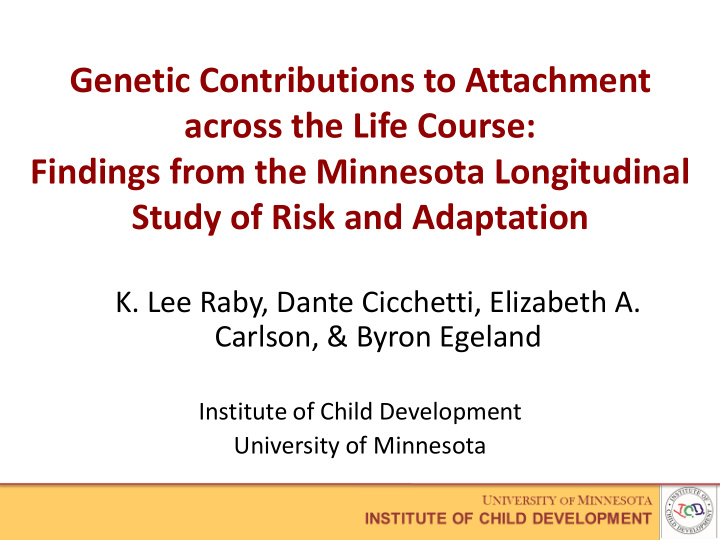



Genetic Contributions to Attachment across the Life Course: Findings from the Minnesota Longitudinal Study of Risk and Adaptation K. Lee Raby, Dante Cicchetti, Elizabeth A. Carlson, & Byron Egeland Institute of Child Development University of Minnesota
Overview of the MLSRA Sample • Born between 1975 and 1977 to first-time mothers living in poverty Research design • Followed from birth to mid-adulthood • Low attrition since early childhood Genetic data collected at age 32 • No diff’s in DNA ( n = 158) and attrition subsamples
Research questions Origins of infant attachment Do genetic variations contribute to attachment security and/or specific attachment behaviors? Stability and change in attachment security across development Are there genetic contributions to the continuity of attachment security after infancy?
Genetic and caregiving-based contributions to infant attachment: Unique associations with distress reactivity and attachment security Psych. Science , 2012
Background • Temperament vs. attachment: an old debate • A possible resolution: temperament influences type of (in)security during the SSP – Use sub-classifications to group infants according to their distress reactivity (Thompson & Lamb, 1984) • Low distress: A 1 -B 2 • High distress: B 3 -C 1 – Infant temperament predicts distress reactivity but not security vs. insecurity (Belsky & Rovine, 1987)
Research questions Does infant’s genotype predict distress reactivity during the SSP? • Serotonin transporter VNTR (5HTTLPR) – “short” allele associated with increased risk for depression and temperamental difficulty in early childhood (Caspi et al., 2010; Cutuli et al., in press) Does 5HTTLPR predict attachment security? • Short allele may interact with maternal responsiveness to predict security (Barry et al., 2008)
Measures Maternal responsiveness • Home observations during feeding and play interactions at 6 months 5HTTLPR • 56 l/l, 68 s/l, 31 s/s Strange Situation at 12m and 18m • Classified as secure (B) vs. insecure (A or C) • Classified as high (B 3 – C 2 ) or low distress (A 1 – B 2 )
Results: Attachment security
Results: Distress reactivity
Conclusions • Infant attachment security as a relationship construct • Failure to replicate Barry et al., (2008) – 5HTTLPR did not significantly moderate the association between responsiveness and security – Sample differences or Type-1 error? • Potential genetic contributions to infants’ distress during SSP – 5HTTLPR may bias toward attachment classifications that reflect infants’ reactions to distressing events
Genetic contributions to continuity and change in attachment security: A prospective, longitudinal investigation from infancy to young adulthood
Background • Modest stability in attachment security from infancy to young adulthood (Fraley, 2002) • Individual characteristics as potential moderators of the continuity of attachment security (Thompson, 2006; Waters et al., 2000). • Reiner & Spangler (2010) – DRD4 moderates associations between adults ’ retrospective reports of childhood caregiving experiences and adult attachment security
Research question Does genetic variation moderate the stability of attachment security from infancy to young adulthood?
Measures Infant attachment security • % of times securely attached at 12m and 18m Genetic variation • 5HTTLPR VNTR, DRD4 VNTR, and OXTR rs53576 Adult attachment security • Adult Attachment Interview: age 19 and age 26 • Current Relationship Interview: 20-21 and 26-28
Results: AAI at age 19 Main effects β p SSP security .19 .02 OXTR .02 .92 DRD4 -.10 .32 5HTT .11 .26 Interactive effects β p SSP x OXTR .18 .02 SSP x DRD4 .08 .45 SSP x 5HTT .23 .01
Results: AAI at age 19 6.0 OXTR G/G 5.5 OXTR A/A or A/G AAI security 5.0 β = .36 ** 4.5 4.0 β = .04 3.5 3.0 0% 50% 100% SSP security
Results: AAI at age 26 Main effects β p SSP security .13 .11 OXTR .04 .66 DRD4 .13 .12 5HTT .02 .85 Interactive effects β p SSP x OXTR .19 .02 SSP x DRD4 .16 .14 SSP x 5HTT -.01 .75
Results: AAI at age 26 6.0 β = .36 ** OXTR G/G 5.5 OXTR A/A or A/G AAI security 5.0 4.5 β = -.03 4.0 3.5 3.0 0% 50% 100% SSP security
CRI at ages 20 – 21 Main effects β p SSP security .09 .45 OXTR -.11 .32 DRD4 -.11 .34 5HTT .02 .86 Interactive effects β p SSP x OXTR .12 .12 SSP x DRD4 -.17 .17 SSP x 5HTT -.15 .20
CRI at ages 26 – 28 Main effects β p SSP security .17 .17 OXTR .05 .67 DRD4 .06 .66 5HTT -.11 .37 Interactive effects β p SSP x OXTR .23 .03 SSP x DRD4 .05 .72 SSP x 5HTT -.01 .98
CRI at ages 26 – 28 6.0 OXTR G/G 5.5 β = .42 ** OXTR A allele 5.0 CRI security 4.5 β = .05 4.0 3.5 3.0 0% 50% 100% SSP security
Conclusions • Potential role for genetically based sensitivity to change in attachment security – OXTR G/G more likely to show continuity in security or insecurity – OXTR A allele more likely to change • Specific to OXTR • Remaining questions – Does this replicate? – Biological and psychological mechanisms?
Acknowledgements Funding Collaborators • National Institute of Mental • Andy Collins • J.J. Cutuli Health • National Institute of Child • Alan Sroufe Health and Human Development MLSRA staff • Center for Neurobehavioral • Judy Cook Development • Michelle Englund • Brian Peterson Genetics lab staff • Susan Hetzel
Recommend
More recommend